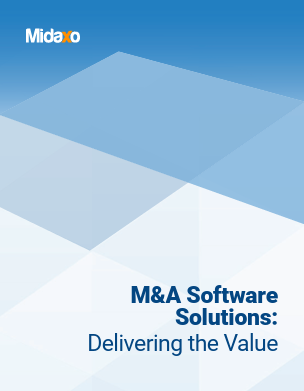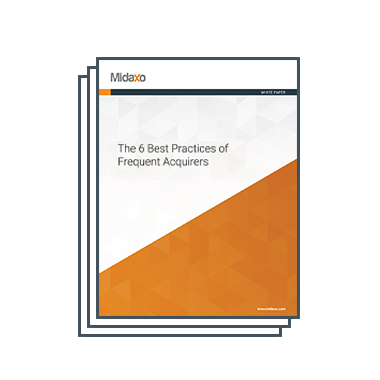Properly leveraging M&A software is one of the foundational elements of building internal M&A capabilities and extracting deal value, but with so many offerings on the market, the process of selecting the best one has become cumbersome. Unfortunately, the price of choosing the wrong deal management software is quite high.
According to Bain & Company, current key trends in the buyer M&A landscape are retaining talent and capturing revenue synergies. Both of these goals can be easily shattered without robust collaboration and communication and streamlined integration plans and strategies. These focal points of deal success link directly back to the importance of M&A deal management software. With this in mind, below we review the benefits of deal flow management software and highlight key considerations when selecting the most appropriate platform in 2022.
What are the key benefits of deal flow software?
- Real-time collaboration — Real-time collaboration and transparency are two of the hallmarks of M&A software and platforms. For powerful collaboration there must be one source of truth that breaks teams out of silos and ensures critical information is getting passed on from one stage of the deal to the next. Moreover, real-time collaboration also allows leaders to have an aerial view of the process, which, in turn, allows for potential roadblocks and problems to be easily flagged. Time becomes a salient factor in the M&A process, and the best deal flow software allows users to work faster and more efficiently due to real time collaboration.
- M&A expertise — The most effective deal flow software options are created specifically for M&A practitioners by M&A experts. As a result, M&A expertise (via deal flow features, templates, and playbooks) is built into the software and, therefore, strategically guides buyers and sellers in the right direction. To fully reap these benefits, practitioners must consider the software company they will be partnering with and the type of ongoing support the company will provide.
- Data visualization — Data visualization is another key benefit of using deal flow management software. Specifically, data visualization is especially critical during the due diligence stage. In fact, Deloitte has found that data visualization “enables the due diligence team to raise focused questions and gain deeper insights.” Additionally, “visualizing an area can often lead to breakthrough moments.”
- Built in VDR — By now, VDRs are commonplace in the world of M&A; however, this does not diminish their role. The best M&A software has a built-in VDR so users have information in one place and one source of truth to enhance communication, collaboration, and workflow. Eliminating one-off tools ensures information is not lost as a deal moves from one stage to the next. In fact, having all information in one central location increases the integrity and usefulness of the data.
- Purpose-built CRM — For companies balancing multiple deals at different stages and/or building relationships with multiple potential targets, purpose-built CRM allows users to log calls, emails, and notes with the click of a button. Here, “purpose-built” specifically for M&A is key; traditional CRMs often fall short of what is needed for mergers and acquisitions. However, software that boasts purpose-built CRM for M&A results in stronger, more strategically sound deals.
Overall, these features allow users to close deals faster, while also remaining focused on their established deal thesis and capturing the intended deal value.
What are the Key Considerations When Selecting Deal Flow Management Software?
While applications may vary slightly depending on individual companies’ needs, the following five focal points will help ensure acquirers are directing their attention to the most salient aspects of deal flow management software.
- User experience — Software solutions are only as good as the user’s ability to engage with them. As a result, companies must consider their overarching M&A goals, strengths and weaknesses, and level of M&A experience. Similarly, one of the premiere methods in selecting M&A software is to speak to others in the industry and ask for reviews on what they are using and what they found in their research. Of course, stemming from all of this is the importance of selecting a software solution that is intuitive for users – the world of M&A is busy and chaotic enough without having to spend large amounts of time understanding and learning a tool that is meant to be time-saving.
- Security — All information throughout the M&A process must be secure and accounted for. Security breaches and information leaks can lead to embarrassing consequences for companies. When researching deal flow management software, customers must look for the top levels of certifications and compliance; ISO 27001 certification is recognized as the premiere global certification. Additionally, an examination of control settings is critical as throughout the deal’s lifecycle who has access to specific information will be limited and altered.
- Collaboration features — Communication and collaboration are especially critical when transitioning from one stage of the deal to the next. For instance, robust collaboration is needed for successful PMI (post-merger integration). Without collaborative planning for PMI, or ensuring information from due diligence is successfully transfered to the integration team, company culture and synergy capture will both suffer. Consequently, some features to look for include: the ability to assign and track tasks, click of a button reporting and analytics, dashboards with key metrics for stakeholders, and a deal kanban.
- Deal scoring — Systemized deal scoring allows acquirers to quickly and accurately determine which deals they should be focusing on; therefore, carefully crafted deal scoring features should be an integral part of a business’ deal management software. Ideally, the software will allow the user to set the criteria and report the deal scoring in a clear, visual manner. Ranking features, as well as synergy overviews are also immensely helpful. Unfortunately, deal scoring features traditionally have not received as much attention in the world of M&A platforms, but they are vital in ensuring the acquirer is staying true to its overarching M&A goals and strategy.
- Transformational power — Deal flow management software has the power to assist users in developing a disciplined, programmatic M&A approach that will yield positive, sustained results. With this in mind, when reviewing providers, practitioners need to ask themselves how each particular software will or will not increase all users’ focus on the overarching deal thesis and, in return, increase the likelihood of extracting the full intended deal value.
Final Thoughts
M&A is booming, and as companies continue to buy and sell each other (rather quickly, we should note), they cannot ignore utilizing strategic deal management software that serves its users from end to end. Such software can transform the M&A practices of both large and small companies — from those newer to deal management to those who boast a high level of expertise. Ultimately, the facts do not lie: there is a strong return on investment (ROI) when leveraging the right deal flow management software.





